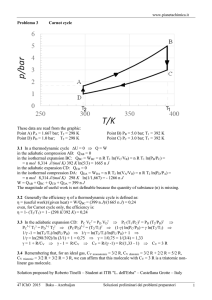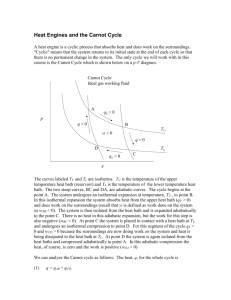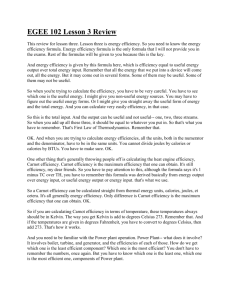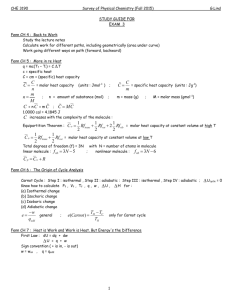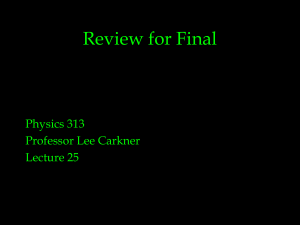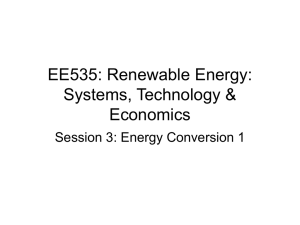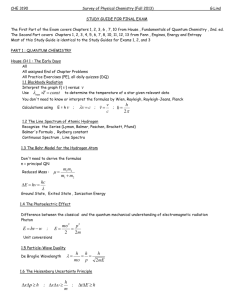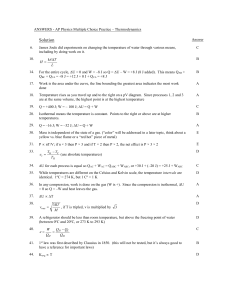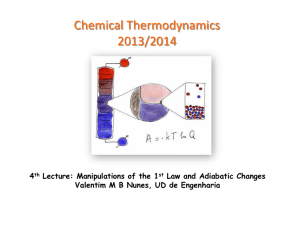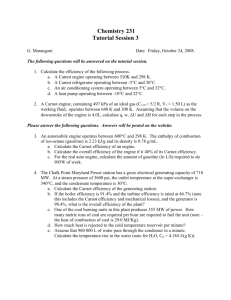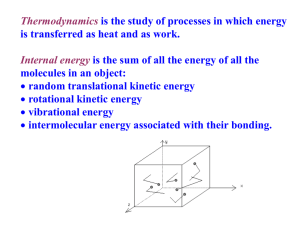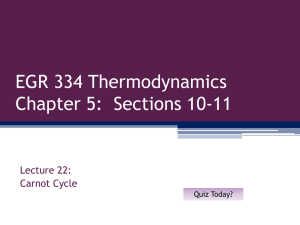Basic thermodynamics PPT
advertisement
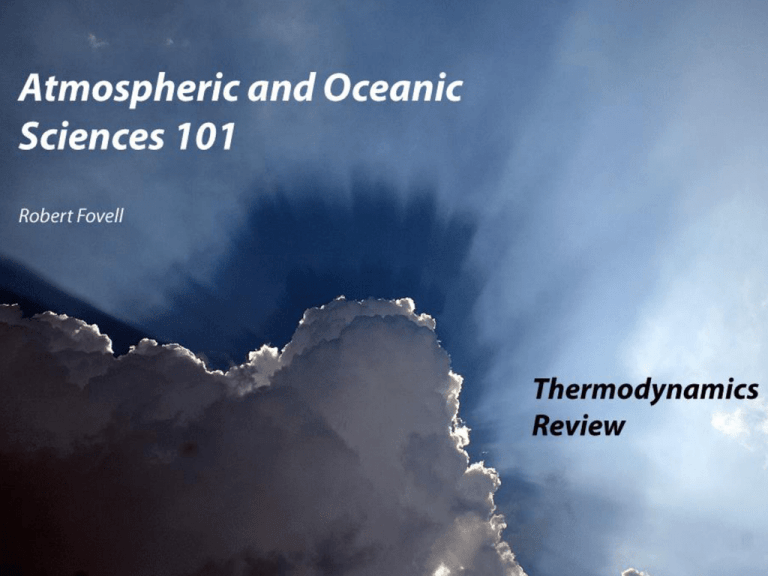
1 Outline • • • • Define terms and conventions Introduce 1st law of thermodynamics Contrast state and non-state properties Describe the Carnot cycle 2 System and environment • System = what we wish to study – View as control mass or control volume • Control mass (CM) – Define some mass, hold fixed, follow it around • Control volume (CV) – Define and monitor a physical space • Environment = everything else that may interact with the system 3 System states • Systems may be open or closed to mass – Open systems permit mass exchange across system boundaries – Our CVs are usually open – Strictly speaking, a CM is closed • Closed systems may be isolated or nonisolated – Isolated systems do not permit energy transfer with environment – Closed, isolated system = environment doesn’t matter 4 Lagrangian vs. Eulerian • CM is the Lagrangian viewpoint – Powerful, desirable but often impractical – Total derivatives – Freeway example • CV is the Eulerian viewpoint – Observe flow through volume – Partial derivatives 5 Air parcel • Our most frequently used system • CM (usually!) – Lagrangian concept • Monitor how T, p, and V change as we follow it around 6 Conventions • We often use CAPITAL letters for extensive quantities, and lower case for specific quantities – Specific = per unit mass • Example: – U is internal energy, in Joules – u is specific internal energy, in J/kg – Unfortunately, “u” is also zonal wind velocity • Exceptions: – Temperature T is essentially specific, but capitalized (and isn’t per unit mass anyway) – Pressure p is fundamentally extensive, but lower case 7 Energy and the 1st law • Total energy = KE + PE + IE – Conserved in absence of sources and sinks • Our main use of 1st law: monitor changes in internal energy (IE or u) owing to sources and sinks • How do we change system u? With energy transfer via – heat Q or q – work W or w • Caveat: w is also vertical velocity, and q will be reused (briefly) for water vapor specific humidity 8 Work • Work = force applied over a distance – Force: N, distance: m – Work: Nm = J = energy • Our principal interest: CM volume compression or expansion (dV) in presence of external pressure (p) • W > 0 if dV > 0 9 Work W > 0 when system expands against environment 10 Heat • Diabatic heat – Diabatic: Greek for “passable, to be passed through” – Internal energy exchanged between system and environment – q > 0 when energy flow is INTO system • Adiabatic = system is isolated – Adiabatic: impassable, not to be passed through 11 Caution on nomenclature • We should use diabatic when the energy exchange is between system and environment • But, what if the heat source or sink is inside the system? – That’s adiabatic, but q ≠ 0 – Our interior heat source will be water changing phase • Dry adiabatic: q = 0 – No heat source, outside OR inside – “dry” really means no water phase changes • Moist adiabatic: q ≠ 0, but heat source/sink is inside system – “moist” implies water phase change – Synonyms include “saturated adiabatic” and “wet adiabatic” – Can also be referred to as “diabatic”! 12 1st law • In the absence of ∆KE and ∆PE • Other ways of writing this Most of my examples will be per unit mass. 13 State properties • Internal energy u is a state property • Changes in state properties are not pathdependent • Other state properties include m, T, p, r, V, etc. 14 State properties 15 Path-dependence • Work and heat are path-dependent 16 Path-dependence • A cyclic process starts and ends with the same state property values • … but the cyclic process can have net heat exchange and do net work 17 Path-dependence 18 Path-dependence 19 Carnot cycle • 4-step piston cycle on a CM • 2 steps of volume expansion, 2 of volume compression • 2 steps are isothermal, 2 are (dry) adiabatic • Warm and cold thermal reservoirs external to system • Start and end with temperature T1 and volume V1 20 Carnot – Step 1 Isothermal volume expansion Add heat QA from warm reservoir T2 = T1 V2 > V1 21 Carnot – Step 2 Adiabatic volume expansion No heat exchange T3 < T2 V3 > V2 22 Carnot – Step 3 Isothermal volume compression Lose heat QB to cold thermal reservoir T4 = T3 V4 < V3 23 Carnot – Step 4 Adiabatic volume compression No heat exchange T1 > T4 V1 < V4 Returned to original state T1, V1. Cycle is complete. 24 25 Apply 1st law 26 Carnot on T-V diagram 27 Carnot on T-V diagram 28 Carnot on T-V diagram 29 Carnot on T-V diagram 30 Carnot on T-V diagram 31 Carnot on T-V diagram 32 Carnot on T-V diagram No net ∆V But did net W 33 Conceptual summary Heat flow diverted to do work 34 Question for thought #1 The isothermal expansion (QA) occurred at a higher temperature than the Isothermal compression (QB). What does this imply for the work? QB is waste heat. What does this imply for the efficiency of this heat engine? Is there a limit to efficiency? Is the limit found in the 1st law? 35 Question for thought #2 Can you design a cyclic process that does no net work? What would it look like on a T-V diagram? 36 Summary • 1st law says, in essence, if you can’t take the heat, you can’t do the work • Work and heat are path-dependent • Carnot cycle illustrates isothermal and (dry) adiabatic processes – Heat diverted to do work, but some is wasted W = Q A - QB 37
